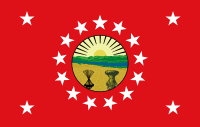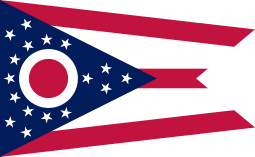Andrew Hickenlooper
| Andrew Hickenlooper | |
|---|---|
 Andrew Hickenlooper | |
| Born |
August 10, 1837 Hudson, Ohio |
| Died |
May 12, 1904 (aged 66) Cincinnati, Ohio |
| Place of burial | Spring Grove Cemetery, Cincinnati, Ohio |
| Allegiance |
United States of America Union |
| Service/branch |
United States Army Union Army |
| Years of service | 1862 – 1865 |
| Rank |
|
| Commands held |
5th Ohio Independent Battery Chief of Staff, XVIII Corps |
| Battles/wars | |
| Other work | Lieutenant Governor of Ohio |
| Wikimedia Commons has media related to Andrew Hickenlooper. |
Andrew Hickenlooper (August 10, 1837 – May 12, 1904)[1] was an Ohio civil engineer, politician, industrialist, and most famously, an officer who served as a General in the Union Army during the American Civil War.
Biography
Hickenlooper was born in the village of Hudson, Ohio. He attended Woodward College and Xavier College. When he was nineteen, he entered the office of A. W. Gilbert, then the city surveyor of Cincinnati, and thoroughly mastered the duties of the position. Three years later, he became the city surveyor himself. After spending two years in this position, the Civil War broke out. He was married to Maria Lloyd Smith and had two children.[2]
Civil War Career
Although he was only twenty-four, he recruited what was known as Hickenlooper's Battery or the 5th Ohio Independent Battery, and joined Maj. Gen. John C. Fremont at Jefferson City, Missouri. In 1862, his battery was made a part of the Army of the Tennessee and took a distinguished part in the Battle of Shiloh. Hickenlooper managed to save four of his six guns after the initial Confederate attack. He later defended the famous Hornet's Nest in support of Benjamin M. Prentiss's division. For gallantry at Shiloh, he became commandant of artillery in Thomas J. McKean's division and later chief of staff of the XVII Corps.
During the Vicksburg Campaign, Brig. Gen. James McPherson wrote to Secretary of War Edwin Stanton that, as Hickenlooper's further promotion in the line of the artillery service was impossible, that he be given special consideration for promotion. Hickenlooper served through the Atlanta campaign as an engineer with distinguished honor and participated in Sherman's March to the Sea, and the advance through the Carolinas. He was endorsed for brigadier general by Generals William Sherman, Oliver O. Howard, and Ulysses S. Grant. On May 20, 1865, be became a brevet brigadier general.
Civilian career
After the war, Hickenlooper was appointed United States marshal for the Southern district of Ohio. Then he served two terms as city civil engineer. While in this office, he was made assistant to W.W. Scarborough, then the president of the Cincinnati Gas Company, with the title of vice president. He served as vice president but for a short time, as he was then elected president of the company. He published two books, Competition in the Manufacture and Delivery of Gas (1881), and Incandescent Electric Lights for Street Illumination (1886).He became active in veterans affairs, particularly those of the Society of the Army of the Tennessee, serving as its Corresponding Secretary, where he worked tirelessly for the erection of monuments to the memory of his friend and mentor, General James B. McPherson
Political career
In 1879, he was elected the 15th Lieutenant Governor of Ohio under Governor Charles Foster and declined a renomination in 1881. He served one term as president of the Cincinnati Chamber of Commerce.[3] In 1902, he published a book on the Battle of Shiloh.
Death and legacy
Hickenlooper died in Cincinnati with a distinguished civil and military reputation. He is buried in Spring Grove Cemetery, Cincinnati.[4] On January 3, 1912, a statue in honor of Hickenlooper was erected in Vicksburg National Military Park.
His great-grandson is politician John Hickenlooper, Governor of Colorado.
See also
Further reading
- Bearss, Edwin C., The Vicksburg Campaign, 3 volumes, Morningside Press, 1991, ISBN 0809332698
References
- ↑ "Andrew Hickenlooper". Find A Grave. Retrieved 30 August 2012.
- ↑ "Andrew Hicklooper". Find A Grave. Retrieved 30 August 2012.
- ↑ Goss, Charles Frederic (1912). Cincinnati, the Queen City, 1788-1912. 2. Cincinnati: S J Clarke Publishing Company. p. 361.
- ↑ "Judge Civil War Generals" (PDF). The Spring Grove Family. Retrieved July 18, 2014.
External links
- Ballard, Michael B., Vicksburg, The Campaign that Opened the Mississippi, University of North Carolina Press, 2004, ISBN 0-8078-2893-9.
- Daniel, Larry, Shiloh: The Battle that Changed the Civil War, Simon and Schuster, 1997, ISBN 0-684-83857-5.
- Eicher, John H., and Eicher, David J., Civil War High Commands, Stanford University Press, 2001, ISBN 0-8047-3641-3.
- Sword, Wiley, Shiloh: Bloody April, Morningside Books, 1974, ISBN 0-89029-770-3.
- Reid, Whitelaw (1895). "Andrew Hickenlooper". Ohio in the War Her Statesmen Generals and Soldiers. 1. Cincinnati: The Robert Clarke Company. pp. 937–939.
- 5th Ohio Independent Battery
- Obituary in the Cincinnati Times-Star
- "Andrew Hickenlooper". Find a Grave. Retrieved 2008-02-12.
| Preceded by Jabez W. Fitch |
Lieutenant Governor of Ohio 1880-1882 |
Succeeded by Rees G. Richards |
| Preceded by Edwin Stevens |
President of Cincinnati Chamber of Commerce 1886-1887 |
Succeeded by Levi C. Goodale |

